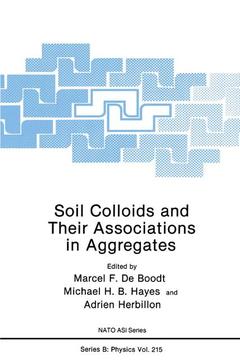Soil Colloids and Their Associations in Aggregates, 1990 NATO Science Series B: Series, Vol. 214
Langue : Anglais
Coordonnateurs : De Boodt Marcel F., Hayes Michael H.B., Herbillon Adrien

S. Henin Versailles, France It was a pleasure for me to take part in the NATO Advanced Study Workshop for studies of 'Soil Colloids and their Associations in Soil Aggregates'. The meeting provided me with a welcome opportunity to renew acquaintances with respected colleagues in the various fields of Soil Science, to listen to their presentations, and be involved in discussions which were at the frontiers of the science which deals with the structures and the associations of the soil colloidal constituents. In my view the rapid advances in Soil Science, and the great benefits to agriculture from these, have their origins in the emerging understanding of the structures and the associations of the different soil colloids. It is clear that much research is still needed before the molecular details of the most important of the structures and of the interactions are fully understood. The associations between the soil colloids, and the manner in which they bind to or hold the other constituents of soils in aggregates is fundamental to soil fertility. and the Modem intensive agriculture leads to the degradation of soil structure subsequent loss through erosion of a resource that is vital for the production of food. This degradation is considered to result primarily from the biological oxidation of the indigenous soil organic matter, and from the failure to return to the soil sufficient organic residues to compensate for such losses.
I: Soil Inorganic Colloids.- 1 Structure, Crystal Chemistry, and Origin of the Phyllosilicate Minerals Common in Soil Clays.- 2 Some Properties of Clays and of other Soil Colloids and their Influences on Soils.- 3 Some Properties of Soil and Synthetic Iron Oxides.- 4 Some Observations on the Formation and Transformation of Iron Oxides.- 5 Interaction of Stable and Metastable Monomeric Iron(III) Species with a Kaolinitic Soil Clay.- 6 The Use of Mössbauer Spectroscopy in the Study of Soil Colloidal Materials.- 7 Soil Manganese Oxides.- 8 Structures and Genesis of Allophanes and Imogolite and their Distribution in Non-Volcanic Soils.- 9 Organo-alumino Polymer Associations and their Significance in Soil and Environmental Sciences.- II: Soil Organic Colloids.- 10 Genesis, Isolation, Composition and Structures of Soil Humic Substances.- 11 Composition, Origins, Structures, and Reactivities of Soil Polysaccharides.- 12 Microorganisms, Enzymes and Soil Colloid Surfaces.- III: Water and Clays.- 13 Structure and Dynamics of Water at Clay Surfaces. Inferences from Neutron Scattering Studies.- 14 Behaviour and Microstructure of Clay Minerals.- IV: Soil Aggregates.- 15 Characterisation of the Sand, Silt, and Clay Fractions of some Mollisols.- 16 Interparticle Forces in Relation to the Stability of Soil Aggregates.- 17 Associations of Colloids in Soil Aggregates.- 18 Soil Aggregates — Formation and Stability.- V: Soil Conditioners and Soil Aggregates.- 19 Applications of Polymeric Substances as Physical Soil Conditioners.- 20 Applications of Soil Conditioners for Agriculture and Engineering.- 21 Erosion Control in the Tropics.- Author Index.
Date de parution : 07-2013
Ouvrage de 598 p.
15.5x23.5 cm
Thèmes de Soil Colloids and Their Associations in Aggregates :
Mots-clés :
© 2024 LAVOISIER S.A.S.



